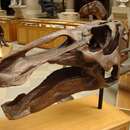en
names in breadcrumbs


Discovered by Lawrence Lambe in 1920, Edmontosaurus annectens lived 71 to 66 million years ago in the Late Cretaceous period, during the time period directly prior to the mass extinction event that killed all non-avian dinosaurs (1). At an estimated 9 m long and 3200 kg,E. annectenswas one of the largest herbivores in its environment. Numerous specimens of this taxon have been discovered, including several of the famous “mummies,” which show preserved skin texture (2).E. annectensfossils have been found throughout Colorado, Wyoming, South Dakota, Montana, Alberta, and Saskatchewan in formations such as the Hell Creek Formation (2). This dinosaur is known to have traveled in large herds with thousands of individuals, and was preyed upon by Tyrannosaurus rex (3).
Edmontosaurus annectens is known from fossil deposits throughout both the United States and Canada. It lived in the Maastrichtian of the Late Cretaceous approximately 71 to 66 million years ago, during the interval prior to the mass extinction that killed all non-avian dinosaurs.E. annectensis a very common fossil from this time period and likely was one of the most abundant dinosaurs in its environment as well (1).
One of the locations whereE. annectenshas been found is the Hell Creek Formation. This environment was a subtropical forested floodplain, with plants such as angiosperms, cypress, ferns, and ginkos. A wide diversity of animal fossils have been found in similar deposits, indicating that species like freshwater turtles, mammals, and monitor lizards would have lived alongsideE. annectens. Other dinosaurs commonly found at the same sites asE. annectensinclude Triceratops, Thescelosaurus, and Tyrannosaurus rex (2). Healed bite marks onE. annectensbones indicate that it was predated upon by T. rex (3).
E. annectensfossils have also been found in the Lance Formation in Wyoming. Unlike the Hell Creek Formation, this environment was a bayou setting with higher humidity levels. Once more, Thescelosaurus and Triceratops seem to have shared this environment withE. annectens. This location has been known to produce spectacularly preserved fossils, such as the twoE. annectens“mummy” specimens (2).
Edmontosaurus annectens remains are often found in large groups, which has been used to suggest that these dinosaurs lived in herds (1). At the Lance Formation in Wyoming, over 10,000E. annectensindividuals are preserved (2). The wide geographic range whereE. annectensfossils are found have led some paleontologists to conclude thatE. annectensunderwent seasonal migration, possibly traveling as far as 2,600 km round-trip per year (3). This hypothesis is disputed by others, who suggest thatE. annectensspent the winter in polar locations. Overwintering behavior inE. annectensis supported by Chinsamy et al. (4), who found bone microstructure differences between polarE. annectensand temperateE. annectens. The bones in polarE. annectensshow signs of periodic nutrient deficit, which could be explained by harsh polar winter conditions decreasing quality of food. TemperateE. annectensshow some signals indicating lack of food resource availability, but it does not have the yearly regularity of polarE. annectens. Additionally, youngE. annectensindividuals have been discovered at polar locations that would have been too small to undergo successful migration (5, 6).
Edmontosaurus annectens was a very successful herbivore and was highly adapted for a grazing lifestyle. Its jaw structure permitted grinding motions, with hundreds of teeth being progressively worn down and replaced in massive dental batteries. These dental batteries were made up of hundreds of small, slender teeth that were packed very closely together. As such, they formed surfaces that were excellent for grinding up tough plant material. It could feed on plants from the ground up to approximately 4 meters high (1), and likely fed from both leaves and branches in this range (2).
Dramatic ornamentation of the skull is seen throughout Hadrosauridae, the dinosaur family containing Edmontosaurus. Parasaurolophus, a related species, has a particularly dramatic crest, and there has been a wide range of debate as to what the function of such a structure may have been. Edmontosaurus annectens, on the other hand, shows no skeletal evidence of skull ornamentation (1). Because of this, they have been thought to portray the ancestral condition of Hadrosauridae (2), though the accuracy of this idea has been questioned (1).
Evidence has been found for a crest made of soft-tissue in a closely related dinosaur species, Edmontosaurus regalis. This fleshy crest appears similar to a rooster’s comb. While it is possible thatE. annectenscould have had a similar crest, there is currently no evidence of this (3).
Many specimens of Edmontosaurus annectens have been discovered, but the most famous may be the “Trachodon mummy.” The mummy was first discovered in Wyoming in 1908. The skeleton is surrounded by detailed sandstone skin and tissue impressions. The texture of the skin was bumpy, covered in small nodes called tubercles. Originally the specimen was interpreted to show evidence of webbed feet, but this is now regarded as a result of tissue degredation rather than morphology. To this day, the Trachodon mummy is regarded as one of the best-preserved dinosaur fossils ever found (1, 2, 3).